Community
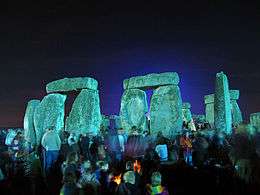
| Part of a series on |
| Community |
|---|
| Academic studies |
| Key concepts |
|
| Community development |
| See also |
|
A community is a small or large social unit (a group of living things) that has something in common, such as norms, religion, values, or identity. Communities often share a sense of place that is situated in a given geographical area (e.g. a country, village, town, or neighborhood) or in virtual space through communication platforms. Durable relations that extend beyond immediate genealogical ties also define a sense of community. People tend to define those social ties as important to their identity, practice, and roles in social institutions (such as family, home, work, government, society, or humanity at-large).[1][2] Although communities are usually small relative to personal social ties (micro-level), "community" may also refer to large group affiliations (or macro-level), such as national communities, international communities, and virtual communities.[3]
The English-language word "community" derives from the Old French comuneté, which comes from the Latin communitas "community", "public spirit" (from Latin communis, "shared in common").[4]
Human communities may share intent, belief, resources, preferences, needs, and risks in common, affecting the identity of the participants and their degree of cohesiveness.
Perspectives of various disciplines
Archaeology
In archaeological studies of social communities the term "community" is used in two ways, paralleling usage in other areas. The first is an informal definition of community as a place where people used to live. In this sense it is synonymous with the concept of an ancient settlement, whether a hamlet, village, town, or city. The second meaning is similar to the usage of the term in other social sciences: a community is a group of people living near one another who interact socially. Social interaction on a small scale can be difficult to identify with archaeological data. Most reconstructions of social communities by archaeologists rely on the principle that social interaction is conditioned by physical distance. Therefore, a small village settlement likely constituted a social community, and spatial subdivisions of cities and other large settlements may have formed communities. Archaeologists typically use similarities in material culture—from house types to styles of pottery—to reconstruct communities in the past. This is based on the assumption that people or households will share more similarities in the types and styles of their material goods with other members of a social community than they will with outsiders.[5]
Ecology
In ecology, a community is an assemblage of populations of different species, interacting with one another. Community ecology is the branch of ecology that studies interactions between and among species. It considers how such interactions, along with interactions between species and the abiotic environment, affect community structure and species richness, diversity and patterns of abundance. Species interact in three ways: competition, predation and mutualism. Competition typically results in a double negative—that is both species lose in the interaction. Predation is a win/lose situation with one species winning. Mutualism, on the other hand, involves both species cooperating in some way, with both winning. The two main types of communities are major which are self-sustaining and self-regulating (such as a forest or a lake) and minor communities which rely on other communities (like fungi decomposing a log) and are the building blocks of major communities.
.svg.png)
Key concepts
Gemeinschaft and Gesellschaft
In Gemeinschaft und Gesellschaft (1887), German sociologist Ferdinand Tönnies described two types of human association: Gemeinschaft (usually translated as "community") and Gesellschaft ("society" or "association"). Tönnies proposed the Gemeinschaft–Gesellschaft dichotomy as a way to think about social ties. No group is exclusively one or the other. Gemeinschaft stress personal social interactions, and the roles, values, and beliefs based on such interactions. Gesellschaft stress indirect interactions, impersonal roles, formal values, and beliefs based on such interactions.[6]
Internet communities
Groups of people are complex, in ways that make those groups hard to form and hard to sustain; much of the shape of traditional institutions is a response to those difficulties. New social tools relieve some of those burdens, allowing for new kinds of group-forming, like using simple sharing to anchor the creation of new groups.
One simple form of cooperation, almost universal with social tools, is conversation; when people are in one another's company, even virtually, they like to talk. Conversation creates more of a sense of community than sharing does.
Collaborative production is a more involved form of cooperation, as it increases the tension between individual and group goals. The litmus test for collaborative production is simple: no one person can take credit for what gets created, and the project could not come into being without the participation of many.
An online community builds weaker bonds if allows users to be anonymous. Clay Shirky, a researcher on digital media, states in reference to the audience of an online community, "An audience isn’t just a big community; it can be more anonymous, with many fewer ties among users. A community isn’t just a small audience either; it has a social density that audiences lack." The sites that offer online communities, like Myspace, Twitter, Facebook, Instagram, Tumblr, and Pinterest allow users to "stalk" their community and act anonymously.[7]
Organizational communication
Effective communication practices in group and organizational settings are very important to the formation and maintenance of communities. The ways that ideas and values are communicated within communities are important to the induction of new members, the formulation of agendas, the selection of leaders and many other aspects. Organizational communication is the study of how people communicate within an organizational context and the influences and interactions within organizational structures. Group members depend on the flow of communication to establish their own identity within these structures and learn to function in the group setting. Although organizational communication, as a field of study, is usually geared toward companies and business groups, these may also be seen as communities. The principles of organizational communication can also be applied to other types of communities.
Public administration
Public administration is the province of local, state and federal governments, with local governments responsible for units in towns, cities, villages, and counties, among others. The most well known "community department" is housing and community development which has responsibility for both economic development initiatives, and as public housing and community infrastructure (e.g., business development).
Sense of community
In a seminal 1986 study, McMillan and Chavis[8]}} identify four elements of "sense of community":
- membership,
- influence,
- integration and fulfillment of needs,
- shared emotional connection.
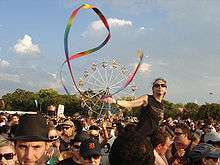
A "sense of community index (SCI) was developed by Chavis and colleagues, and revised and adapted by others. Although originally designed to assess sense of community in neighborhoods, the index has been adapted for use in schools, the workplace, and a variety of types of communities.[9]
Studies conducted by the APPA indicate that young adults who feel a sense of belonging in a community, particularly small communities, develop fewer psychiatric and depressive disorders than those who do not have the feeling of love and belonging.
Socialization
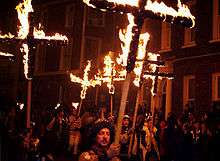
The process of learning to adopt the behavior patterns of the community is called socialization. The most fertile time of socialization is usually the early stages of life, during which individuals develop the skills and knowledge and learn the roles necessary to function within their culture and social environment.[10] For some psychologists, especially those in the psychodynamic tradition, the most important period of socialization is between the ages of one and ten. But socialization also includes adults moving into a significantly different environment, where they must learn a new set of behaviors.[11]
Socialization is influenced primarily by the family, through which children first learn community norms. Other important influences include schools, peer groups, people, mass media, the workplace, and government. The degree to which the norms of a particular society or community are adopted determines one's willingness to engage with others. The norms of tolerance, reciprocity, and trust are important "habits of the heart," as de Tocqueville put it, in an individual's involvement in community.[12]
Community development
Community development is often linked with community work or community planning, and may involve stakeholders, foundations, governments, or contracted entities including non-government organisations (NGOs), universities or government agencies to progress the social well-being of local, regional and, sometimes, national communities. More grassroots efforts, called community building or community organizing, seek to empower individuals and groups of people by providing them with the skills they need to effect change in their own communities.[13] These skills often assist in building political power through the formation of large social groups working for a common agenda. Community development practitioners must understand both how to work with individuals and how to affect communities' positions within the context of larger social institutions. Public administrators, in contrast, need to understand community development in the context of rural and urban development, housing and economic development, and community, organizational and business development.
Formal accredited programs conducted by universities, as part of degree granting institutions, are often used to build a knowledge base to drive curricula in public administration, sociology and community studies. The General Social Survey from the National Opinion Research Center at the University of Chicago and the Saguaro Seminar at the John F. Kennedy School of Government at Harvard University are examples of national community development in the United States. The Maxwell School of Citizenship and Public Affairs at Syracuse University in New York State offers core courses in community and economic development, and in areas ranging from non-profit development to US budgeting (federal to local, community funds). In the United Kingdom, Oxford University has led in providing extensive research in the field through its Community Development Journal,[14] used worldwide by sociologists and community development practitioners.
At the intersection between community development and community building are a number of programs and organizations with community development tools. One example of this is the program of the Asset Based Community Development Institute of Northwestern University. The institute makes available downloadable tools[15] to assess community assets and make connections between non-profit groups and other organizations that can help in community building. The Institute focuses on helping communities develop by "mobilizing neighborhood assets" — building from the inside out rather than the outside in.[16] In the disability field, community building was prevalent in the 1980s and 1990s with roots in John McKnight's approaches.[17][18]
Community building and organizing
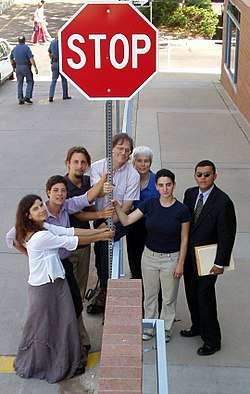
In The Different Drum: Community-Making and Peace (1987) Scott Peck argues that the almost accidental sense of community that exists at times of crisis can be consciously built. Peck believes that conscious community building is a process of deliberate design based on the knowledge and application of certain rules.[19] He states that this process goes through four stages:[20]
- Pseudocommunity: When people first come together, they try to be "nice" and present what they feel are their most personable and friendly characteristics.
- Chaos: People move beyond the inauthenticity of pseudo-community and feel safe enough to present their "shadow" selves.
- Emptiness: Moves beyond the attempts to fix, heal and convert of the chaos stage, when all people become capable of acknowledging their own woundedness and brokenness, common to human beings.
- True community: Deep respect and true listening for the needs of the other people in this community. <>
In 1991, Peck remarked that building a sense of community is easy but maintaining this sense of community is difficult in the modern world.[21]
The three basic types of community organizing are grassroots organizing, coalition building, and "institution-based community organizing," (also called "broad-based community organizing," an example of which is faith-based community organizing, or Congregation-based Community Organizing).[22]
Community building can use a wide variety of practices, ranging from simple events (e.g., potlucks, small book clubs) to larger-scale efforts (e.g., mass festivals, construction projects that involve local participants rather than outside contractors).
Community building that is geared toward citizen action is usually termed "community organizing."[23] In these cases, organized community groups seek accountability from elected officials and increased direct representation within decision-making bodies. Where good-faith negotiations fail, these constituency-led organizations seek to pressure the decision-makers through a variety of means, including picketing, boycotting, sit-ins, petitioning, and electoral politics. <>
Community organizing can focus on more than just resolving specific issues. Organizing often means building a widely accessible power structure, often with the end goal of distributing power equally throughout the community. Community organizers generally seek to build groups that are open and democratic in governance. Such groups facilitate and encourage consensus decision-making with a focus on the general health of the community rather than a specific interest group.
If communities are developed based on something they share in common, whether location or values, then one challenge for developing communities is how to incorporate individuality and differences. Rebekah Nathan suggests in her book, My Freshman Year, we are drawn to developing communities totally based on sameness, despite stated commitments to diversity, such as those found on university websites.
Community currencies
Some communities have developed their own local exchange trading systems (LETS)[24] and local currencies, such as the Ithaca Hours system,[25] to encourage economic growth and an enhanced sense of community. Community currencies have recently proven valuable in meeting the needs of people living in various South American nations, particularly Argentina, that recently suffered as a result of the collapse of the Argentinian national currency.[26]
Community services
Community services are a wide range of community institutions, governmental and non-governmental services, voluntary, third sector organizations, and grassroots and neighborhood efforts in local communities, towns, cities, and suburban-exurban areas. In line with governmental and community thinking, volunteering and unpaid services are often preferred (e.g., altruism, beneficence) to large and continued investments in infrastructure and community services personnel, with private-public partnerships often common.
Non-profit organizations from youth services, to family and neighborhood centers, recreation facilities, civic clubs, and employment, housing and poverty agencies are often the foundation of community services programs, but it may also be undertaken under the auspices of government (which funds all NGOs), one or more businesses, or by individuals or newly formed collaboratives. Community services is also the broad term given to health and the human services in local communities and was specifically used as the framework for deinstitutionalization and community integration to homes, families and local communities (e.g., community residential services).[27]
In a broad discussion of community services, schools, hospitals, clinics, rehabilitation and criminal justice institutions also view themselves as community planners and decisionmakers together with governmental leadership (e.g., city and county offices, state-regional offices). However, while many community services are voluntary, some may be part of alternative sentencing approaches in a justice system and it can be required by educational institutions as part of internships, employment training, and post-graduation plans.
Community services may be paid for through different revenue streams which include targeted federal funds, taxpayer contributions, state and local grants and contracts, voluntary donations, Medicaid or health care funds, community development block grants, targeted education funds, and so forth. In the 2000s, the business sector began to contract with government, and also consult on government policies, and has shifted the framework of community services to the for-profit domains.
However, by the 1990s, the call was to return to community and to go beyond community services to belonging, relationships, community building and welcoming new population groups and diversity in community life.[28][29][30]
Types of community
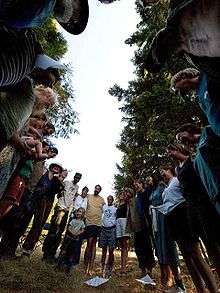
A number of ways to categorize types of community have been proposed. One such breakdown is as follows:
- Location-based Communities: range from the local neighbourhood, suburb, village, town or city, region, nation or even the planet as a whole. These are also called communities of place.
- Identity-based Communities: range from the local clique, sub-culture, ethnic group, religious, multicultural or pluralistic civilisation, or the global community cultures of today. They may be included as communities of need or identity, such as disabled persons, or frail aged people.
- Organizationally based Communities: range from communities organized informally around family or network-based guilds and associations to more formal incorporated associations, political decision making structures, economic enterprises, or professional associations at a small, national or international scale.
The usual categorizations of community relations have a number of problems:[31] (1) they tend to give the impression that a particular community can be defined as just this kind or another; (2) they tend to conflate modern and customary community relations; (3) they tend to take sociological categories such as ethnicity or race as given, forgetting that different ethnically defined persons live in different kinds of communities — grounded, interest-based, diasporic, etc.[32]
In response to these problems, Paul James and his colleagues have developed a taxonomy that maps community relations, and recognizes that actual communities can be characterized by different kinds of relations at the same time:[33]
- Grounded community relations. This involves enduring attachment to particular places and particular people. It is the dominant form taken by customary and tribal communities. In these kinds of communities, the land is fundamental to identity.
- Life-style community relations. This involves giving primacy to communities coming together around particular chosen ways of life, such as morally charged or interest-based relations or just living or working in the same location. Hence the following sub-forms:
- community-life as morally bounded, a form taken by many traditional faith-based communities.
- community-life as interest-based, including sporting, leisure-based and business communities which come together for regular moments of engagement.
- community-life as proximately-related, where neighbourhood or commonality of association forms a community of convenience, or a community of place (see below).
- Projected community relations. This is where a community is self-consciously treated as an entity to be projected and re-created. It can be projected as through thin advertising slogan, for example gated community, or can take the form of ongoing associations of people who seek political integration, communities of practice[34] based on professional projects, associative communities which seek to enhance and support individual creativity, autonomy and mutuality. A nation is one of the largest forms of projected or imagined community.
In these terms, communities can be nested and/or intersecting; one community can contain another—for example a location-based community may contain a number of ethnic communities.[35] Both lists above can used in a cross-cutting matrix in relation to each other.
Location
Possibly the most common usage of the word "community" indicates a large group living in close proximity. Examples of local community include:
- A municipality is an administrative local area generally composed of a clearly defined territory and commonly referring to a town or village.
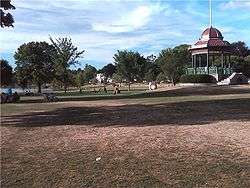
- Although large cities are also municipalities, they are often thought of as a collection of communities, due to their diversity.
- A neighborhood is a geographically localized community, often within a larger city or suburb.
- A planned community is one that was designed from scratch and expanded more or less following the plan. Several of the world's capital cities are planned cities, notably Washington, D.C., in the United States, Canberra in Australia, and Brasília in Brazil. It was also common during the European colonization of the Americas to build according to a plan either on fresh ground or on the ruins of earlier Amerindian cities. Community service is a free service.
Identity
In some contexts, "community" indicates a group of people with a common identity other than location. Members often interact regularly. Common examples in everyday usage include:
- A "professional community" is a group of people with the same or related occupations. Some of those members may join a professional society, making a more defined and formalized group. These are also sometimes known as communities of practice.
- A virtual community is a group of people primarily or initially communicating or interacting with each other by means of information technologies, typically over the Internet, rather than in person. These may be either communities of interest, practice or communion. Research interest is evolving in the motivations for contributing to online communities.
- These communities are key to our modern day society, because we have the ability to share information with millions in a matter of seconds.
Overlaps
Some communities share both location and other attributes. Members choose to live near each other because of one or more common interests.
- A retirement community is designated and at least usually designed for retirees and seniors—often restricted to those over a certain age, such as 56. It differs from a retirement home, which is a single building or small complex, by having a number of autonomous households.
- An intentional community is a deliberate residential community with a much higher degree of social communication than other communities. The members of an intentional community typically hold a common social, political or spiritual vision and share responsibilities and resources. Intentional communities include Amish villages, ashrams, cohousing, communes, ecovillages, housing cooperatives, kibbutzim, and land trusts.
Special nature of human community
Definitions of community as "organisms inhabiting a common environment and interacting with one another,"[36] while scientifically accurate, do not convey the richness, diversity and complexity of human communities. Their classification, likewise is almost never precise. Untidy as it may be, community is vital for humans. M. Scott Peck expresses this in the following way: "There can be no vulnerability without risk; there can be no community without vulnerability; there can be no peace, and ultimately no life, without community."[37]
See also

- Circles of Sustainability
- Communitarianism
- Community theatre
- Engaged theory
- Outline of community
- Wikipedia community
Notes
- ↑ "Community : The Blackwell Encyclopedia of Sociology : Blackwell Encyclopedia of SociolOnline". www.sociologyencyclopedia.com. Retrieved 2016-07-01.
- ↑ James, Paul; Nadarajah, Yaso; Haive, Karen; Stead, Victoria (2012). Sustainable Communities, Sustainable Development: Other Paths for Papua New Guinea. Honolulu: University of Hawaii Press. p. 14.
[...] we define community very broadly as a group or network of persons who are connected (objectively) to each other by relatively durable social relations that extend beyond immediate genealogical ties and who mutually define that relationship (subjectively) as important to their social identity and social practice.
- ↑ See also: James, Paul (2006). Globalism, Nationalism, Tribalism: Bringing Theory Back In —Volume 2 of Towards a Theory of Abstract Community. London: Sage Publications.
- ↑ "community" Oxford Dictionaries. May 2014. Oxford Dictionaries
- ↑ Canuto, Marcello A. and Jason Yaeger (editors) (2000) The Archaeology of Communities. Routledge, New York. Hegmon, Michelle (2002) Concepts of Community in Archaeological Research. In Seeking the Center: Archaeology and Ancient Communities in the Mesa Verde Region, edited by Mark D. Varien and Richard H. Wilshusen, pp. 263–279. University of Utah Press, Salt Lake City.
- ↑ Tönnies, Ferdinand (1887). Gemeinschaft und Gesellschaft, Leipzig: Fues's Verlag. An English translation of the 8th edition 1935 by Charles P. Loomis appeared in 1940 as Fundamental Concepts of Sociology (Gemeinschaft und Gesellschaft), New York: American Book Co.; in 1955 as Community and Association (Gemeinschaft und gesellschaft[sic]), London: Routledge & Kegan Paul; and in 1957 as Community and Society, East Lansing: Michigan State U.P. Loomis includes as an Introduction, representing Tönnies' "most recent thinking", his 1931 article "Gemeinschaft und Gesellschaft" in Handwörterbuch der Soziologie (Stuttgart, Enke V.).
- ↑ Skirty, Clay (2008). Here Comes Everybody. Penguin Group. pp. Chapter 2. ISBN 978-1-59420-153-0.
- ↑ McMillan, D.W., & Chavis, D.M. 1986. "Sense of community: A definition and theory," p. 16.
- ↑ Perkins, D.D., Florin, P., Rich, R.C., Wandersman, A. & Chavis, D.M. (1990). Participation and the social and physical environment of residential blocks: Crime and community context. American Journal of Community Psychology, 18, 83–115. Chipuer, H. M., & Pretty, G. M. H. (1999). A review of the Sense of Community Index: Current uses, factor structure, reliability, and further development. Journal of Community Psychology, 27(6), 643–658. Long, D.A., & Perkins, D.D. (2003). Confirmatory Factor Analysis of the Sense of Community Index and Development of a Brief SCI. Journal of Community Psychology, 31, 279–296.
- ↑ Newman, D. 2005. Chapter 5. "Building Identity: Socialization" pp. 134–140.
- ↑ Newman, D. 2005, p. 141.
- ↑ Smith, M. 2001. Community.
- ↑ Kelly, Anthony, "With Head, Heart and Hand: Dimensions of Community Building" (Boolarong Press) ISBN 978-0-86439-076-9
- ↑ Community Development Journal, Oxford University Press
- ↑ ABCD Institute, in cooperation with the W.K. Kellogg Foundation. 2006. Discovering Community Power: A Guide to Mobilizing Local Assets and Your Organization's Capacity.
- ↑ ABCD Institute. 2006. Welcome to ABCD.
- ↑ Lutfiyya, Z.M (1988, March). Going for it": Life at the Gig Harbor Group Home. Syracuse, NY: Syracuse University Center on Human Policy, Research and Training Center on Community Integration.
- ↑ McKnight, J. (1989). Beyond Community Services. Evanston, IL: Northwestern University, Center of Urban Affairs and Policy Research.
- ↑ M. Scott Peck, (1987). The Different Drum: Community-Making and Peace, pp. 83–85.
- ↑ Peck (1987), pp. 86–106.
- ↑ M. Scott Peck (1991). "The Joy of Community". An interview with M. Scott Peck by Alan Atkisson. In Context #29, p. 26.
- ↑ Jacoby Brown, Michael, (2006), Building Powerful Community Organizations: A Personal Guide To Creating Groups That Can Solve Problems and Change the World (Long Haul Press)
- ↑ Walls, David (1994) "Power to the People: Thirty-five Years of Community Organizing". From The Workbook, Summer 1994, pp. 52–55. Retrieved on: June 22, 2008.
- ↑ Local Exchange Trading Systems were first developed by Michael Linton, in Courtenay, BC, see "LETSystems – new money" Archived 2006-08-19 at the Wayback Machine.. Retrieved: 2006-08-01.
- ↑ The Ithaca Hours system, developed by Paul Glover is outlined in "Creating Community Economics with Local Currency" Archived 2006-07-15 at the Wayback Machine.. Retrieved: 2006-08-01.
- ↑ "Social Trade Organisation". Strohalm.net. Archived from the original on September 29, 2007. Retrieved 2009-04-18.
- ↑ Racino, J. (2014). Public Administration and Disability: Community Services Administration in the US. London and NY, NY: CRC Press.
- ↑ McKnight, J. (1989). Beyond Community Services. Evanston, IL: Northwestern University.
- ↑ O'Brien, J. & O'Brien, C.L. (1995). Building better communities: people with disabilities and their allies. In: T. Philpot & L. Ward, Changing Ideas for Services for People with Learning Difficulties. Oxford, UK: Butterworth-Heinemann.
- ↑ Bogdan, R. & Taylor, S.J. (1999). Building Stronger Communities for All: Thoughts About Community Participation for People with Developmental Disabilities. Syracuse, NY: Center on Human Policy, Syracuse University.
- ↑ Gerhard Delanty, Community, Routledge, London, 2003.
- ↑ James, Paul (2006). Globalism, Nationalism, Tribalism: Bringing Theory Back In—Volume 2 of Towards a Theory of Abstract Community. London: Sage Publications.
- ↑ James, Paul; Nadarajah, Yaso; Haive, Karen; Stead, Victoria (2012). Sustainable Communities, Sustainable Development: Other Paths for Papua New Guinea (pdf download). Honolulu: University of Hawaii Press.
- ↑ Etienne Wenger, Communities of Practice: Learning, Meaning and Identity, Cambridge University Press, Cambridge, 1998.
- ↑ Tropman John E., Erlich, John L. and Rothman, Jack (2006), "Tactics and Techniques of Community Intervention" (Wadsworth Publishing)
- ↑ Australian Academy of Science. Nova: Science in the News Archived 2006-07-17 at the Wayback Machine.. Retrieved: 2006-07-21.
- ↑ Peck (1987), p. 233.
References
| Wikimedia Commons has media related to Community. |
| Look up community in Wiktionary, the free dictionary. |
- Barzilai, Gad. 2003. Communities and Law: Politics and Cultures of Legal Identities. Ann Arbor: University of Michigan Press.
- Beck, U. 1992. Risk Society: Towards a New Modernity. London: Sage: 2000. What is globalization? Cambridge: Polity Press.
- Canuto, Marcello A. and Jason Yaeger, eds. (2000) The Archaeology of Communities. Routledge, New York.
- Chavis, D.M., Hogge, J.H., McMillan, D.W., & Wandersman, A. 1986. "Sense of community through Brunswick's lens: A first look." Journal of Community Psychology, 14(1), 24–40.
- Chipuer, H. M., & Pretty, G. M. H. (1999). A review of the Sense of Community Index: Current uses, factor structure, reliability, and further development. Journal of Community Psychology, 27(6), 643–658.
- Christensen, K., et al. (2003). Encyclopedia of Community. 4 volumes. Thousand Oaks, CA: Sage.
- Cohen, A. P. 1985. The Symbolic Construction of Community. Routledge: New York.
- Durkheim, Émile. 1950 [1895] The Rules of Sociological Method. Translated by S. A. Solovay and J. H. Mueller. New York: The Free Press.
- Cox, F., J. Erlich, J. Rothman, and J. Tropman. 1970. Strategies of Community Organization: A Book of Readings. Itasca, IL: F. E. Peacock Publishers.
- Effland, R. 1998. The Cultural Evolution of Civilizations Mesa Community College.
- Giddens, A. 1999. "Risk and Responsibility" Modern Law Review 62(1): 1–10.
- James, Paul (1996). Nation Formation: Towards a Theory of Abstract Community. London: Sage Publications.
- James, Paul (2006). Globalism, Nationalism, Tribalism: Bringing Theory Back In —Volume 2 of Towards a Theory of Abstract Community. London: Sage Publications.
- James, Paul; Nadarajah, Yaso; Haive, Karen; Stead, Victoria (2012). Sustainable Communities, Sustainable Development: Other Paths for Papua New Guinea. Honolulu: University of Hawaii Press.
- Lenski, G. 1974. Human Societies: An Introduction to Macrosociology. New York: McGraw-Hill, Inc.
- Long, D.A., & Perkins, D.D. (2003). Confirmatory Factor Analysis of the Sense of Community Index and Development of a Brief SCI. Journal of Community Psychology, 31, 279–296.
- Lyall, Scott, ed. (2016). Community in Modern Scottish Literature. Brill | Rodopi: Leiden | Boston.
- McMillan, D.W., & Chavis, D.M. 1986. "Sense of community: A definition and theory." American Journal of Community Psychology, 14(1), 6–23.
- Nancy, Jean-Luc. La Communauté désœuvrée – philosophical questioning of the concept of community and the possibility of encountering a non-subjective concept of it
- Muegge, Steven (2013). "Platforms, communities and business ecosystems: Lessons learned about entrepreneurship in an interconnected world". Technology Innovation Management Review (February): 5–15.
- Newman, D. 2005. Sociology: Exploring the Architecture of Everyday Life, Chapter 5. "Building Identity: Socialization" Pine Forge Press. Retrieved: 2006-08-05.
- Peck, M.S. 1987. The Different Drum: Community-Making and Peace. New York: Simon & Schuster. ISBN 0-684-84858-9
- Perkins, D.D., Florin, P., Rich, R.C., Wandersman, A. & Chavis, D.M. (1990). Participation and the social and physical environment of residential blocks: Crime and community context. American Journal of Community Psychology, 18, 83–115.
- Putnam, R. D. 2000. Bowling Alone: The collapse and revival of American community. New York: Simon & Schuster
- Sarason, S.B. 1974. The psychological sense of community: Prospects for a community psychology. San Francisco: Jossey-Bass.
- — 1986. "Commentary: The emergence of a conceptual center." Journal of Community Psychology, 14, 405–407.
- Smith, M. K. 2001. Community. Encyclopedia of informal education. Last updated: January 28, 2005. Retrieved: 2006-07-15.
- Tönnies, F. 1887. Gemeinschaft und Gesellschaft, Leipzig: Fues's Verlag, 2nd ed. 1912, 8th edition, Leipzig: Buske, 1935; translated in 1957 as Community and Society. ISBN 0-88738-750-0